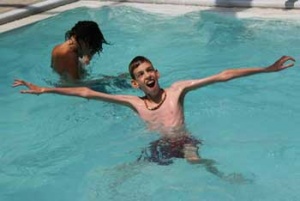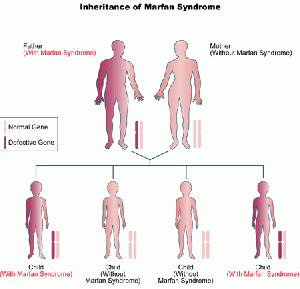Marfan Syndrome
Original Editors - Laura White from Bellarmine University's Pathophysiology of Complex Patient Problems project.
Lead Editors - Your name will be added here if you are a lead editor on this page. Read more.
Definition/Description [edit | edit source]
Marfan syndrome is a genetic disorder of the connective tissue affecting most notably the skeletal system, cardiovascular system, eyes, and skin, among other body systems.[1] Due to the widespread role of connective tissue throughout the body, individuals with Marfan syndrome may be at risk for many potentially severe or lethal co-moribidities as a result of the disease process. Marfan syndrome is inherited through an autosomal dominant mutation of the gene encoding glycoprotein fibrillin-1 (FBN1), which plays a role in the anchoring of cells to the extra-cellular matrix and is the main component of microfibrils .[2][3] Microfibrils affect the strength and elasticity of connective tissue, and also control the release of growth factors that cause growth and repair of tissues and organs throughout the body.[2] A defect in this gene means that the quality and/or quantity of fibrillin-1 in the body is decreased, reducing the amount available to form microfibrils, implicating changes in the body’s connective tissues and growth of tissues.[2] Marfan’s most widely known physical characteristics include a tall, thin build with long fingers, arms, and legs.[4]
[Photo courtesy of National Marfan Foundation. Available at www.marfan.org/marfan/2728/Physical-Activity-Guidelines]
Prevalence[edit | edit source]
Marfan syndrome affects approximately 1 in 5000 people and is equal between men and women as well as between races and ethnicities.[5][6] Marfan syndrome is an autosomal dominant disorder, meaning that children with one affected parent have a 50% chance of inheriting the genetic mutation.[3][4][7][8][9] However, it is estimated that 25% of people with Marfan syndrome did not inherit the disorder but instead experienced a spontaneous genetic mutation at conception of unknown cause.[3][5][7][8][9]
[Image courtesy of Heart.org.in. Available at www.heart.org.in/diseases/marfan-syndrome.html]
Characteristics/Clinical Presentation[edit | edit source]
add text here
Associated Co-morbidities[edit | edit source]
add text here
Medications[edit | edit source]
add text here
Diagnostic Tests/Lab Tests/Lab Values[edit | edit source]
add text here
Etiology/Causes[edit | edit source]
add text here
Systemic Involvement[edit | edit source]
add text here
Medical Management (current best evidence)[edit | edit source]
add text here
Physical Therapy Management (current best evidence)[edit | edit source]
add text here
Alternative/Holistic Management (current best evidence)[edit | edit source]
add text here
Differential Diagnosis[edit | edit source]
add text here
Case Reports/ Case Studies[edit | edit source]
add links to case studies here (case studies should be added on new pages using the case study template)
Resources
[edit | edit source]
add appropriate resources here
Recent Related Research (from Pubmed)
[edit | edit source]
Failed to load RSS feed from http://eutils.ncbi.nlm.nih.gov/entrez/eutils/erss.cgi?rss_guid=123Q1E1Q18WMxrWCl7C_qtsrt5g8Eo6A8spQWMhU4rlndOW9_D|charset=UTF-8|short|max=10: Error parsing XML for RSS
References[edit | edit source]
see adding references tutorial.
- ↑ http://www.ncbi.nlm.nih.gov/pubmedhealth/PMH0001455
- ↑ 2.0 2.1 2.2 http://www.merckmanuals.com/professional/sec19/ch284/ch284d.html?qt=Marfan%20syndrome&alt=sh
- ↑ 3.0 3.1 3.2 National Library of Medicine- Genetics Home Reference: http://ghr.nlm.nih.gov/condition/marfan-syndrome
- ↑ 4.0 4.1 Mayo Clinic: http://www.mayoclinic.com/health/marfan-syndrome/DS00540
- ↑ 5.0 5.1 National Marfan Foundation: http://www.marfan.org/marfan/
- ↑ National Human Genome Research Institute: http://www.genome.gov/19519224
- ↑ 7.0 7.1 National Institute of Arthritis and Musculoskeletal and Skin Diseases: http://www.niams.nih.gov/Health_Info/Marfan_Syndrome/default.asp
- ↑ 8.0 8.1 National Heart Lung and Blood Institute’s Diseases and Conditions Index: http://www.nhlbi.nih.gov/health/dci/Diseases/mar/mar_whatis.html
- ↑ 9.0 9.1 9. Cleveland Clinic: http://my.clevelandclinic.org/heart/disorders/aorta_marfan/marfan.aspx








